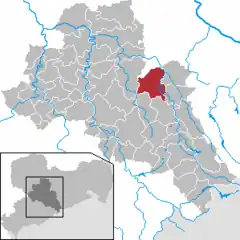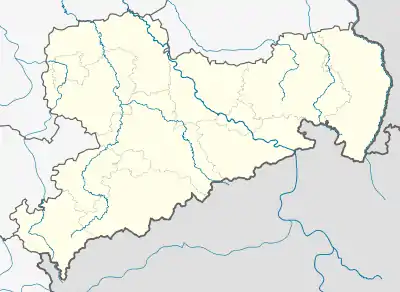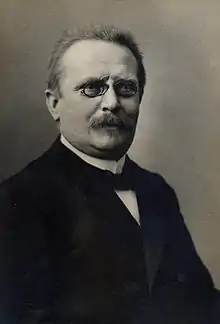Großschirma
Großschirma is a town in the district of Mittelsachsen, in Saxony, Germany. It is situated 7 km northwest of Freiberg. It was formed from the administrative union of the municipality of Großschirma and the town of Siebenlehn, including their districts, on 1 September 2003.
Großschirma | |
|---|---|
 Großschirma town hall | |
 Coat of arms | |
Location of Großschirma within Mittelsachsen district  | |
 Großschirma  Großschirma | |
| Coordinates: 50°57′59″N 13°16′41″E | |
| Country | Germany |
| State | Saxony |
| District | Mittelsachsen |
| Subdivisions | 9 |
| Government | |
| • Mayor (2018–25) | Volkmar Schreiter[1] (FDP) |
| Area | |
| • Total | 61.44 km2 (23.72 sq mi) |
| Elevation | 330 m (1,080 ft) |
| Population (2021-12-31)[2] | |
| • Total | 5,531 |
| • Density | 90/km2 (230/sq mi) |
| Time zone | UTC+01:00 (CET) |
| • Summer (DST) | UTC+02:00 (CEST) |
| Postal codes | 09603 |
| Dialling codes | 037328 |
| Vehicle registration | FG |
| Website | www.grossschirma.de |
History

The eponymous village Großschirma was founded in the middle of the 12th century. Claims by local historians that it was already founded in 956 could not be proved. Until the Protestant Reformation Großschirma belonged to Altzella Abbey. In 1555, prince-elector Augustus sold Großschirma and 14 other villages that were part of the estate of the dissolved abbey to his councillor Ulrich von Mordeisen. Rudolph Mordeisen, one of the sons of the latter, sold Großschirma and at least nine more villages in the property of his family to prince-elector Christian.
Großschirma benefited from the growth of mining in the Freiberg Mining Field. The state-owned mine Churprinz Friedrich August Erbstolln (short: Churprinz) on the west bank of the river Freiberger Mulde was one of the most profitable mines in the field. The ore extracted there was conveyed to the smelters in Halsbrücke on an artificial waterway, the Churprinzer Bergwerkskanal.
In 2003, the hitherto separate town Siebenlehn offered to join the municipality of Großschirma due to financial difficulties. The two municipalities merged on 1 September 2003, whereby the town privileges of Siebenlehn were transferred to the joint municipality. This was the first case of a town being incorporated into a rural municipality in Saxony.
Districts and their incorporations
| Former municipality | Date of incorporation | Note | Inhabitants (2009) |
|---|---|---|---|
| Breitenbach[3] | 1 January 1913 | incorporated into Siebenlehn | |
| Großschirma, Gutsbezirk | around 1922 | 1467 | |
| Großvoigtsberg[4] | 1. March 1994 | 690 | |
| Hohentanne[4] | 1 January 1994 | 263 | |
| Kleinvoigtsberg[4] | 1. März 1994 | 264 | |
| Obergruna[4] | 1 January 1994 | incorporated into Siebenlehn | 498 |
| Reichenbach[4] | 1 January 1999 | 592 | |
| Rothenfurth[5][6] | 1 July 1950 | 313 | |
| Seifersdorf[4] | 1 March 1994 | incorporated into Reichenbach | 315 |
| Siebenlehn[4] | 1 September 2003 | 1527 (with Breitenbach) | |
| Teichhäuser |
Infrastructure
Bundesstraße 101 traverses the area of the municipality from north to south. Motorway A4 runs along the northern boundary of the town, with a junction north-west of Siebenlehn. Nossen–Moldau railway also traverses the town from north to south and has stations in Großvoigtsberg and Großschirma. It is principally used by museum trains and occasional freight trains.
A network of hiking paths and cycling routes, integrated into long-distance routes is maintained by local associations.
Sons and daughters of the city

Otto Rühle (1874–1943) born in Siebenlehn. Foremost radical Marxist associated with Rosa Luxemburg and Alfredd Ardler.
- Amalie Dietrich (1821–1891), born in Siebenlehn, naturalist, botanist, zoologist and plant hunter
- Friedrich Wilhelm Putzger (1849–1913), born in Siebenlehn, educator, schoolbook author
References
- Bürgermeisterwahlen 2018, Freistaat Sachsen, accessed 10 July 2021.
- "Bevölkerung des Freistaates Sachsen nach Gemeinden am 31. Dezember 2021" (XLS) (in German). Statistisches Landesamt des Freistaates Sachsen. 2022.
- Das Sachsenbuch, Kommunal-Verlag Sachsen KG, Dresden, 1943
- Statistisches Landesamt des Freistaates Sachsen: Gebietsänderungen
- Gemeinden 1994 und ihre Veränderungen seit 01.01.1948 in den neuen Ländern, Verlag Metzler-Poeschel, Stuttgart, 1995, ISBN 3-8246-0321-7, Herausgeber: Statistisches Bundesamt
- Verzeichnisse der seit Mai 1945 eingemeindeten Gemeinden und Nachweis über die Aufgliederung der selbständigen Gutsbezirke und Staatsforstreviere, 1952, Herausgeber: Ministerium des Innern des Landes Sachsen